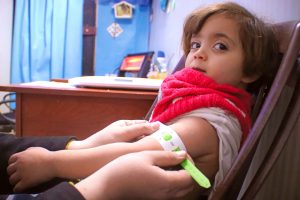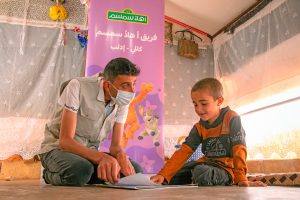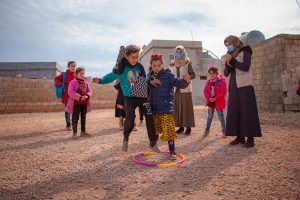
In Syria, over 12 million people are food insecure1 and 1.3 million are severely food insecure. Conditions are particularly dire for children with over 553,000 children are chronically malnourished and 245,000 are acutely malnourished. 2 One in three pregnant women is anemic due to inadequate nutrition.10 Deteriorating economic conditions in Syria and the impact of the COVI-19 pandemic have contributed to such exponential rates of food insecurity and malnutrition among the population. Vital interventions like ready-to-eat therapeutic food and infant and young child feeding (IYCF) programs targeting pregnant and lactating women and their children have proven essential for addressing the hunger crisis.
7,814 women
16,389 children
16,584
Malnutrition Screenings
120
Awareness Sessions
2,254
IYCF Consulations
318
Referrals
Micronutrients provided to:
3,537
Children
&
1,319
Pregnant & Lactating Women and Caregivers
Syria Humanitarian Need Overview [HN0] Syria Humanitarian Needs Oveview (HNC).

Addressing malnutrition in Syria is crucial. The widespread prevalence of this issue poses a severe public health challenge, impacting around 5.5 million children under the age of 5 and pregnant…
DONATEAddressing malnutrition in Syria is crucial. The widespread prevalence of this issue poses a severe public health challenge, impacting around 5.5 million children under the age of 5 and pregnant and lactating women in 2022. Shockingly, one in four Syrian children is experiencing stunting, putting them at grave risk of irreversible harm to their physical and cognitive development, recurring infections, developmental delays, disabilities, and even death.
Pregnant and lactating women face their own challenges, with roughly 265,000 requiring treatment for moderate wasting, and 54 percent of PLW in northwest Syria suffering from severe iron deficiency anemia (classified as severity level 5). Our vital efforts aim to provide essential interventions like ready-to-eat therapeutic foods and Infant and Young Child Feeding (IYCF) programs, targeting pregnant and lactating women and their children. Your support can make a life-changing impact on those facing the dire consequences of malnutrition. Join us in the fight against hunge

In response to the educational challenges in Syria, SRD is actively addressing the issue by providing vocational training to beneficiaries and essential education to humanitarian aid workers in health, protection,…
DONATEIn response to the educational challenges in Syria, SRD is actively addressing the issue by providing vocational training to beneficiaries and essential education to humanitarian aid workers in health, protection, and early recovery sectors. With 2.4 million children out of school and an additional 1.6 million at risk of dropping out, education remains a critically neglected sector, carrying both short-term and long-term implications for Syria’s youth, aspiring workforce, and those compelled to become primary breadwinners due to the conflict, particularly women and children.
This initiative recognizes the urgency of the educational crisis and is committed to the continued provision of informal education. It also introduces more formal initiatives aimed at training and equipping individuals with the tools and resources needed to overcome challenges in both the short and long term. By addressing the educational needs of beneficiaries and aid workers alike, the effort strives to contribute to the resilience of individuals affected by the conflict, paving the way for a brighter and more sustainable future. Join us in empowering minds, nurturing skills, and building a foundation for lasting change.

The ongoing conflict in Syria has left a profound impact on every individual—men, women, and children—resulting in over 14.2 million people desperately in need of safeguarding. With half of the…
DONATEThe ongoing conflict in Syria has left a profound impact on every individual—men, women, and children—resulting in over 14.2 million people desperately in need of safeguarding. With half of the nation’s pre-war population displaced, addressing the consequences extends beyond the conventional boundaries of vulnerability. Protection in this context encompasses not only physical safety but also the intricate emotional and psychological well-being of those affected by the conflict.
Critical physical protection requirements for Syrians include shielding them from aerial bombardments, armed hostilities, sexual and gender-based violence (SGBV), environmental threats, and other factors that worsen negative health outcomes. Simultaneously, addressing the emotional and psychological protection needs necessitates a comprehensive approach that holistically caters to the intricate and diverse needs of these communities.
Our protective measures, spanning general protection, gender-based violence, and child protection, underscore our commitment to creating a safer environment and nurturing the well-being of those enduring the crisis’s repercussions. Join us in fostering resilience and protection for every individual affected by the Syrian conflict.
Notifications